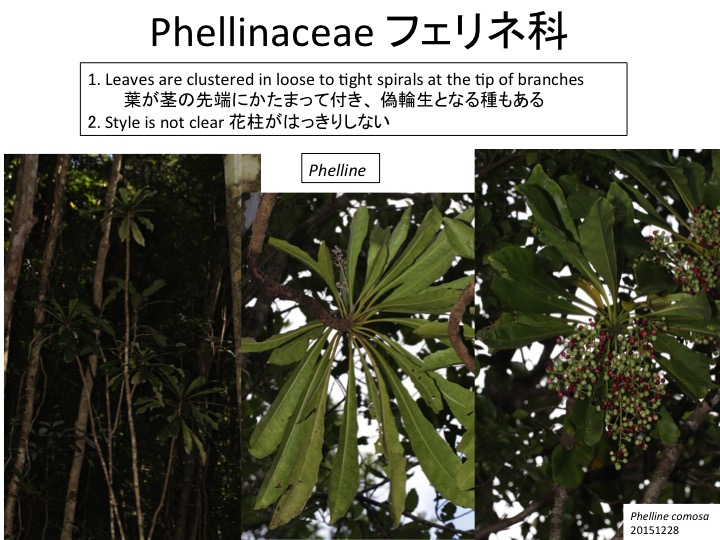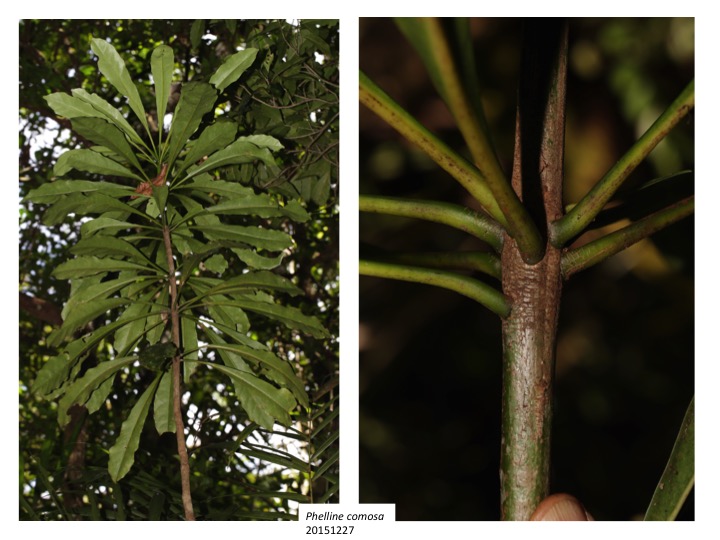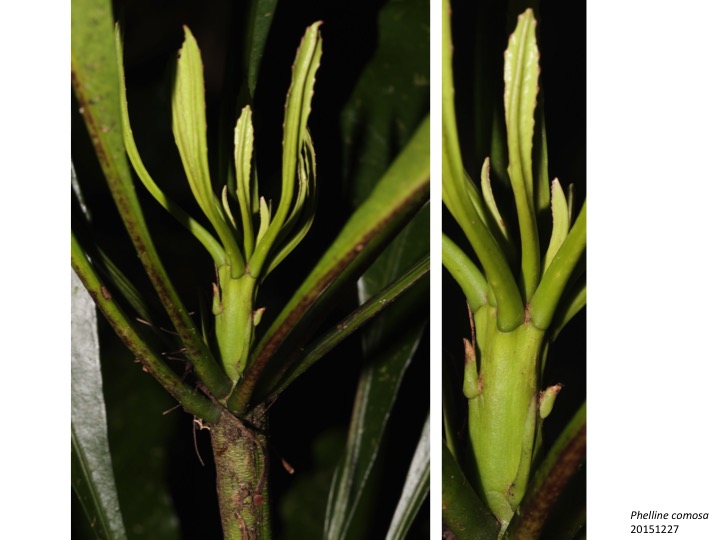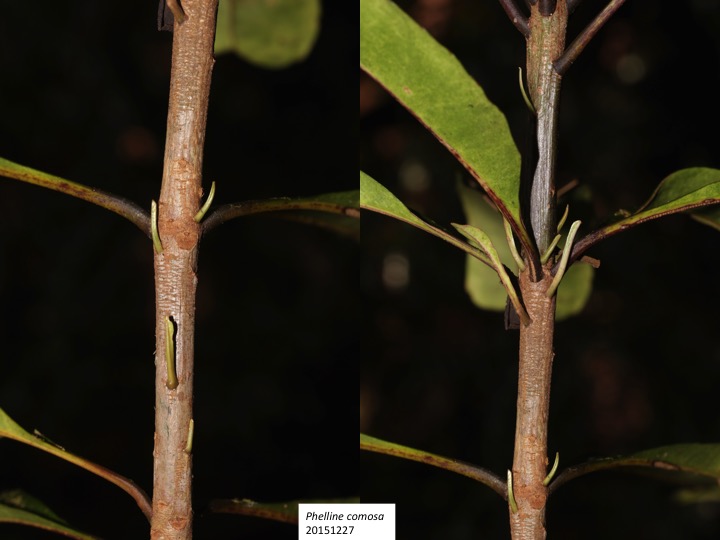Tank, D.C. and Donoghue, M.J. 2010. Phylogeny and phylogenetic nomenclature of the Campanulidae based on an expanded sample of genes and taxa. Syst. Bot. 35: 425-441.
フェリネ科はフェリネ属のみを含み、11種がニューカレドニアのみから知られている(Barriera et al. 2006)。
Phelline is monogenic in the Phellinaceae and11 species are known only in New Caledonia (Barriera et al. 2006).
Barriera, C., Savolainen, V., and Spichiger, R. 2006. Phellinaceae. Pp. 608-610, in Kadereit, J. W. and Jeffrey, C. (eds), The Families and Genera of Vascular Plants VIII Asterales. Springer, Berlin.
Phelline comosaの葉は偽輪生となる。
Leaves of Phelline comosa are clustered in tight spirals at the tip of branches.
葉序は互生だが、数枚ごとに葉と葉の間の茎(節間部)の伸長が長くなるために、輪生のように見える。
Leaves are alternate but some internodes are longer than other internodes.
Phelline comosa には成長期と休眠期がある。休眠期の茎頂を見ると、普通葉の後に鱗片葉が形成されている。ということは、成長期の終わりに鱗片葉を作るのだろう。そして、節間(白色矢印は鱗片葉の落ちた後)や節間遠位部にも鱗片葉があることから、休眠中の茎頂にすでに鱗片葉原基が形成されていて成長期初期にそれらがまず展開し、その後で、普通葉が展開するのか、あるいは、成長期初期に茎頂で最初に新しい鱗片葉原基が形成されるのだろう。Phelline comosaのフェノロジーについての報告は見つけられなかったが、年間を通して茎頂を切片による光学顕微鏡観察、走査電子顕微鏡観察すれば、季節変化と異型葉形成との関係がわかりそうである。
鱗片葉の適応的な意義はなんだろうか。休眠期に形成されることから、休眠中の茎頂保護に役立っているのかもしれない。多くの種子植物は休眠時に鱗片葉を形成する。これらの鱗片葉は次の成長期のために作られた若い葉原基や葉と茎頂を乾燥や昆虫の食害から保護する適応的意義がある。これらに加え、すらっと細く伸びるPhelline comosaの茎は周りの枝に当たる可能性が高く、鱗片葉が傷害からの保護の役割を持つかもしれない。
Phelline comosa has growth and dormant phases. At the dormant phase, scale leaves cover the shoot tip, indicating that Phelline comosa forms scale leaves at the late stage of the growth phase. Since scale leaves also locate on the middle and distal parts of internodes, growth of scale leaves formed at the later stage of the growth phase may be arrested and starts again when dormancy is released. Otherwise, scale leaves are formed at the shoot apex when growth starts, before the formation of normal leaves. I could not find any reports on the phenology of Phelline comosa. Observation of the shoot apex with microscopy for sections and scanning electron microscopy will reveal the relationship between phenology and heteroblasty.
What is the adaptive significance of scale leaves? They should function to protect the shoot meristem from dryness and harmful insects as scale leaves in other seed plants. Furthermore, since stems of Phelline comosa are slender and easily shaken by wind, the scale leaves may protect the shoot meristem from collisions to surrounding trees.
鱗片葉と普通葉を作る発生プログラムはかなり異なったものなのだろうか、あるいは、同じプログラムを使っているが鱗片葉の場合は途中でプログラムが止まっているのだろうか。同じ発生プログラムを途中でとめて、最終形態を変える機構は異時性と呼ばれる現象の範疇にあり、いろいろな生物で知られているが、その分子機構はよくわかっていない。
被子植物では、休眠芽から茎が伸び出す時、最初に展開する葉は通常葉とは、葉序や形態が異なることが多い。また、側芽が伸び出す時は、通常葉とは違った葉序と形態の葉が形成され、前出葉(前葉)と呼ばれる。しかし、休眠芽の発生様式の分子機構はほとんど明らかになっていない。Phelline comosaの鱗片葉も似た機構を使っているのだろうか。
It is unknown whether developmental programs to form scale and normal leaves are similar or different. They may use a similar developmental program, which is arrested at some point in the scale leaf development not to fully make the leaf blade. This is a kind of heterochrony, whose molecular mechanisms are not well known.
It is often observed in angiosperms that morphology and phyllotaxis of early leaves are different from those of later leaves when winter buds start to grow. Lateral branches usually have prophylls with different morphology and phyllotaxis to regular leaves. Molecular mechanisms to form such different types of leaves are mostly unknown. It is also unknown whether scale leaves of Phelline comosa use similar mechanisms.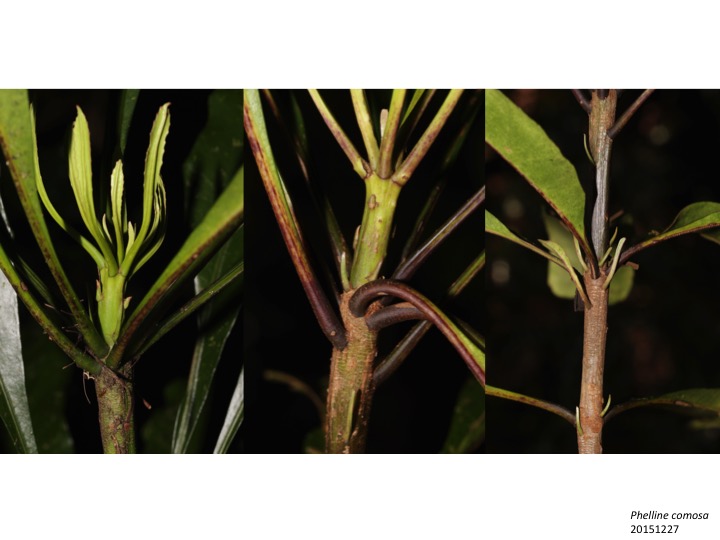
成長期に入り茎が伸長する時、鱗片葉の節間は通常葉の節間よりも長く伸びる。鱗片葉の形成と茎の伸長には関係があるのだろうか。
Phelline comosa has growing and dormant phases. Just after the growing phase starts, internodes of scale leaves are extensively grow. Is there a relationship between scale leaves and rapid growth?
茎の伸長部周辺には鱗片葉がある。普通葉の節間は鱗片葉の節間よりも短い。
Internodes of scale leaves are longer than those of normal leaves.
休眠芽で形成されていた鱗片葉の節間長は通常葉の節間長と変わらない。
Internodes of scale leaves at the base of dormant bud are similar to those of normal leaves.
節間の途中に付く鱗片葉。
Some scale leaves locate on the longer internodes.
ツツジ科イチヤクソウ亜科 Pyroloideae の種も偽輪生になる。コイチヤクソウでは、Phelline comosaのように鱗片葉の付く位置で茎が伸長している。
Relationship between scale leaves and long internode is also observed in other plants. Orthilia secunda (Pyroloideae, Ericaceae) forms pseudo-verticillate leaves and internodes with scale leaves longer than those with normal leaves, as observed in Phelline comosa.
Pyrola chloranthaとイチゲイチヤクソウもツツジ科イチヤクソウ亜科に属する。Pyrola chloranthaもコイチヤクソウのように茎の伸長部に鱗片葉が形成されている。一方で、イチゲイチヤクソウの地上茎では鱗片葉が形成されても茎は伸長しない。Phelline comosa やイチヤクソウ亜科の鱗片葉と茎の伸長の関係は、異型葉性と節間伸長の関係、葉形態と茎形態との関係、長枝と短枝の関係などの植物発生学における一般的な問題につながっていると思われる。
Pyrola chlorantha and Moneses uniflora also belong to Pyroloideae in the Ericaceae. Scale leaves and internode growth are related in Pyrola chlorantha, while they are not in Moneses uniflora. The problem of the relationships between scale and normal leaves in Phelline comosa and Pyroloideae are related to the general questions on the relationships between heteroblasty and internode growth, between leaf and stem morphology, and between long and short branches.
フェリネ属は花序を腋生し、雌雄異株 (Barriera et al. 2006)。Phelline comosaの雌花は小さな雄蕊を形成し花粉も産出するが(白矢印)、花粉に粘性があるかはわからない。
Species in Phelline form axillary inflorescences with dioecious flowers (Barriera et al. 2006). Female flowers of Phelline comosa form both a gynoecium and four stamens, although fertility of the produced pollen are unknown.
Barriera, C., Savolainen, V., and Spichiger, R. 2006. Phellinaceae. Pp. 608-610, in Kadereit, J. W. and Jeffrey, C. (eds), The Families and Genera of Vascular Plants VIII Asterales. Springer, Berlin.
近縁のアルゴフィルム科やアルセウオスミア科では柱頭が広がり、花柱が明確に区別できるが、フェリネ科では柱頭が開かず花柱が不明瞭である。
Style is not clear in Phelline, while that is conspicuous in closely related families, Argophyllaceae and Alseuosmiaceae.
フェリネ属は核果を形成する。中果皮と内果皮は剥がれやすく、内果皮が種皮のように見える。
Phelline forms drupes. Mesocarp and endocarp are easily separated.


